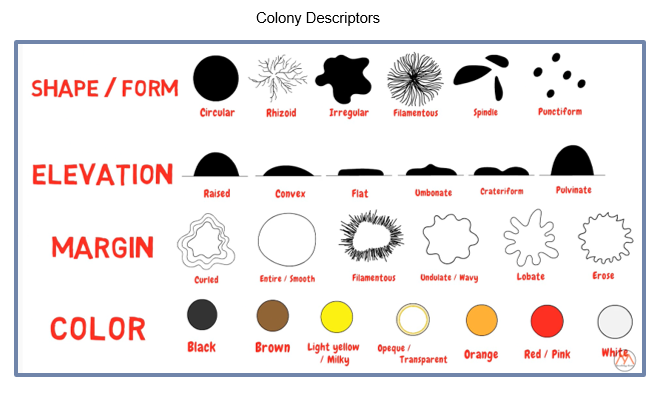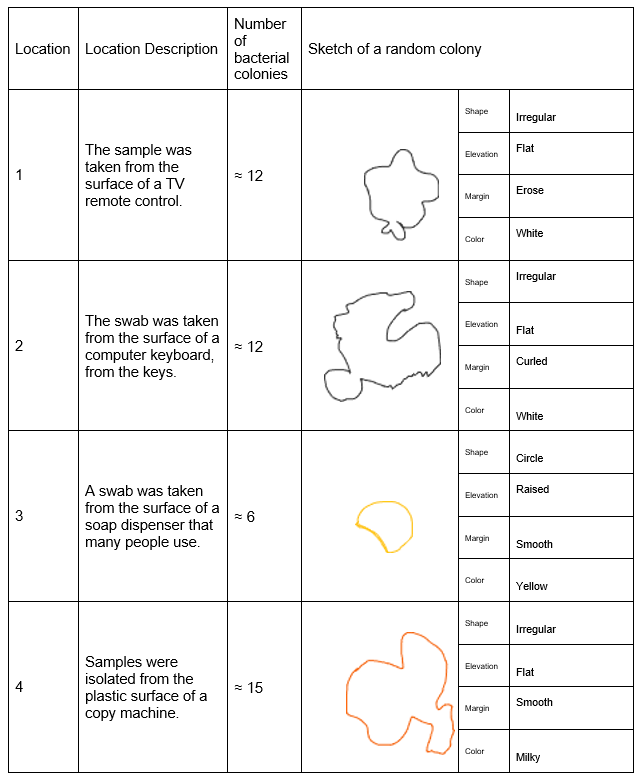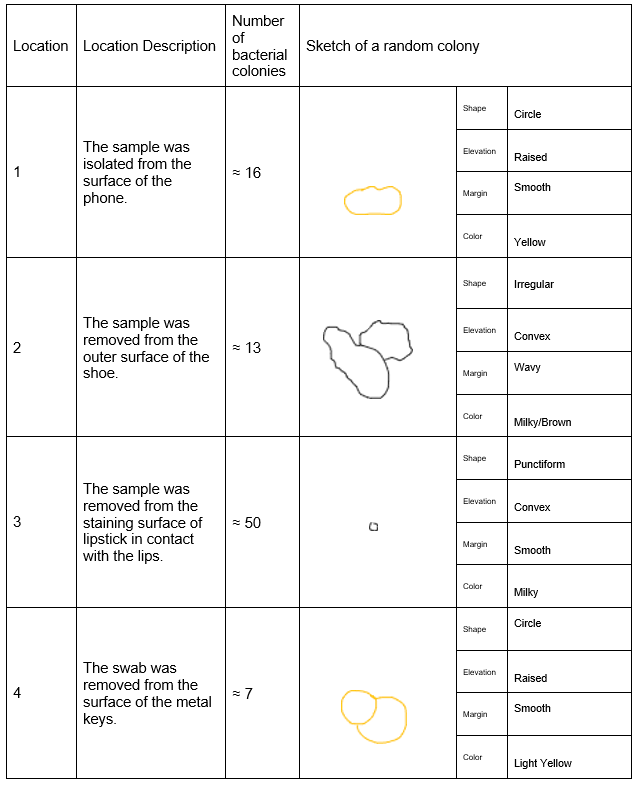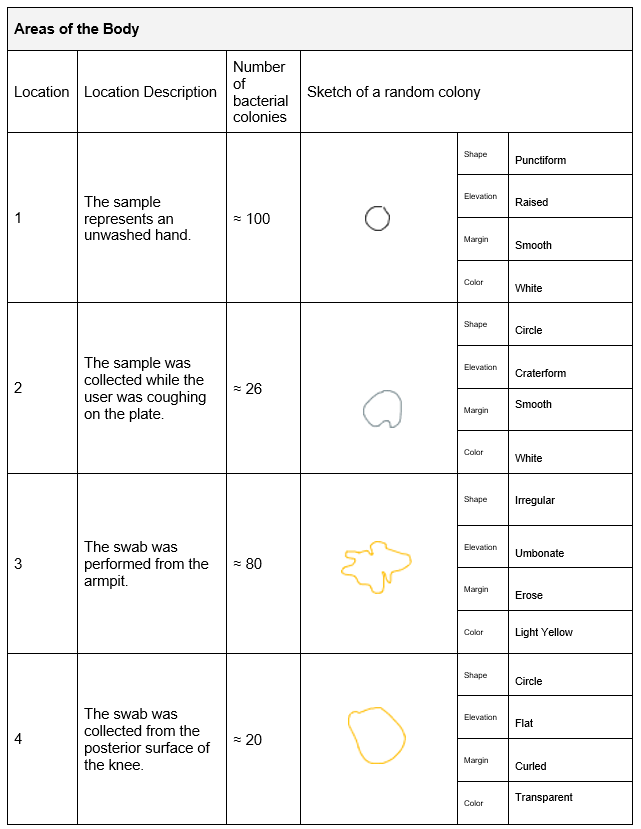Summary
This lab activity will show that bacteria are ubiquitous – meaning that they are found everywhere! You will examine some surfaces and note that while you can’t see individual bacteria because they are so tiny and clear, it is possible to see a colony, or group, of bacteria. Surfaces will be swabbed today, and bacteria will incubate at room temperature for a week. Then, the bacteria will be observed and counted.
Materials
- four nutrient agar plates;
- sharpie;
- 1 vial of sterile water;
- 16 sterile swabs.
Procedure
Label the Plates
- Obtain the nutrient agar plates. With the sharpie, divide each plate into quadrants. (DO NOT WRITE ON THE LID – ONLY WRITE ON THE BASE!).
- Label all four plates with your name.
- Label one plate with one of the four areas below:
- Inside Room;
- Outside the Room;
- Personal Possessions;
- Areas of the Body.
- Label each quadrant sequentially.
- Decide on the four locations within each area that you wish to test (it is completely up to you!). Note those locations on your datasheet.
Obtain the Specimens
- In order to transfer bacteria from one surface to another, it helps if they are moistened. Take a sterile swab and quickly dip it into the sterile water. Be careful not to contaminate the water by keeping the lid open too long.
- Immediately swab the area to be tested. To do this, roll the moist swab across the area, being sure to touch an area of at least 1cm2.
- Carefully open the nutrient agar plate, positioning the lid so that air contamination will not impact the results. Roll the swab across the surface of the agar in the same manner you used to pick up the bacteria. This will transfer the bacteria onto the agar in an exact replica of the way they were on the tested surface.
- Immediately close the lid of the petri dish.
- Discard the swab into the regular trash.
- The sterile water should continue to be sterile and can be used for the entirety of this experiment.
Incubate the Bacteria
- When all four quadrants on all four plates are complete, turn all four petri dishes upside down and tape them together with masking tape. Label the masking tape with your name.
- Place the stack of plates into an incubator set at 22℃. Be sure the plates are upside-down in the incubator.
- Allow plates to incubate for at least 1 week.
Results
- Remove the plates from the incubator and observe and count the number of bacteria on each surface. Record these numbers in the data tables.
- Observe each tested location and choose a colony at random. Sketch this colony and use the colony descriptors below to describe the colony. Record this data in the data tables.





Analysis Questions
Which location had the highest number of bacteria at each location? Highlight the one that is highest overall.
Imagine you did this test and one of the locations did not have any microbial growth. Do you think it is truly sterile? Why or why not?
There are several possible reasons for the apparent lack of microbial growth in the nutrient medium. If one accepts that the swab was effective and that some of the bacteria were indeed transferred to the plate, one should consider possible inhibitory effects. First of all, one would expect that the growth medium components had a deleterious effect on the growth of the microbes, causing them to die as a result. Second, it is likely that the number of bacteria on the site was so small that they were not visible on the plate. Finally, if it is admitted that the prokaryotes were not initially on the surface, then and only then can it be called sterile.
You were instructed not to count any colonies that developed outside of the area where the swab touched the agar. What does it mean if you noticed microbial growth on an area of the petri dish where you are sure the swab did not touch?
If pockets of new bacterial colonies or fungal mold have become visible on the plate outside of the swab contact area, this almost certainly indicates possible contamination of sterile materials during instrument preparation. Ideally, an analytically clean plate with a growth medium (liquid or solid) should be as sterile as possible so that bacteria only grow in a specific area. If the growth medium was contaminated during dish handling when the lid was removed or during transfer, new foci will appear during the incubation period. If the dish was not covered with a lid, some of the microorganisms, and especially the lungs, could have been brought in from the air.
Remember that bacteria need access to food and water. It has been said that there are more bacteria in and on the human body than there are people on Earth! Thinking about the areas that you tested, did you notice a pattern of bacteria being more abundant on the body or things that are touched? Name your location with the least amount of bacteria and your location with the highest amount of bacteria and suggest a reason for the differing amounts.
In this study, bacteriological purity was measured for only four areas of the human body: armpit, palm, back of the knee, and cough. Of these areas, the record for the number of colonies belonged to unwashed hands, which is not surprising given the amount of physical contact the palm has with various surfaces. Including the palm is used to interact with all of the zones described above. At the same time, the least colonies were noticeable from the rear surface of the knee, which can be justified by the low accessibility due to the coverage of the pant/trouser material. However, it is fair to admit that this part of the body actively sweats during physical exertion, which means that the intensity of bacterial colony formation is high here.
In general, of all the surfaces studied, the human body has the most prokaryotes because the body itself is a nutrient substrate for bacteria. The body evaporates moisture, and removes toxins: this is enough to nourish microorganisms, unlike, for instance, a dry bench in a laboratory room.
A common misconception is that bacteria are all the same. Based on what you sketched, how would you describe bacterial colonies?
Bacterial colonies are extremely diverse, dissimilar structures that vary in both color and composition. The studies carried out in this work perfectly demonstrated that bacterial colonies grown even on the same growth medium with minimal spacing between each other have differences. It can be the color shade, the shape of the shell, or the edge structure: these minor changes create an overall difference between the colonies. Thus, each colony represents a separate line of microorganisms, and one can tell from the external differences whether the bacteria are the same strain or different ones.